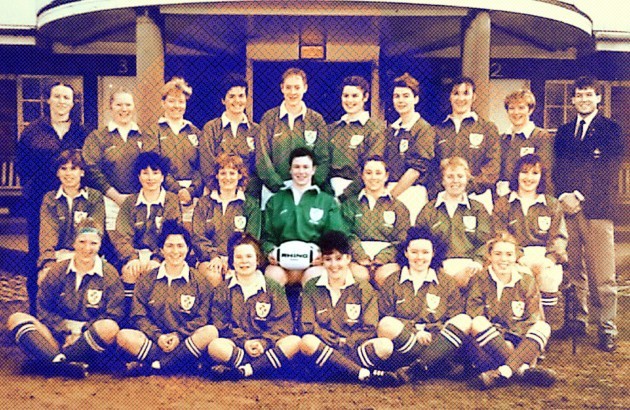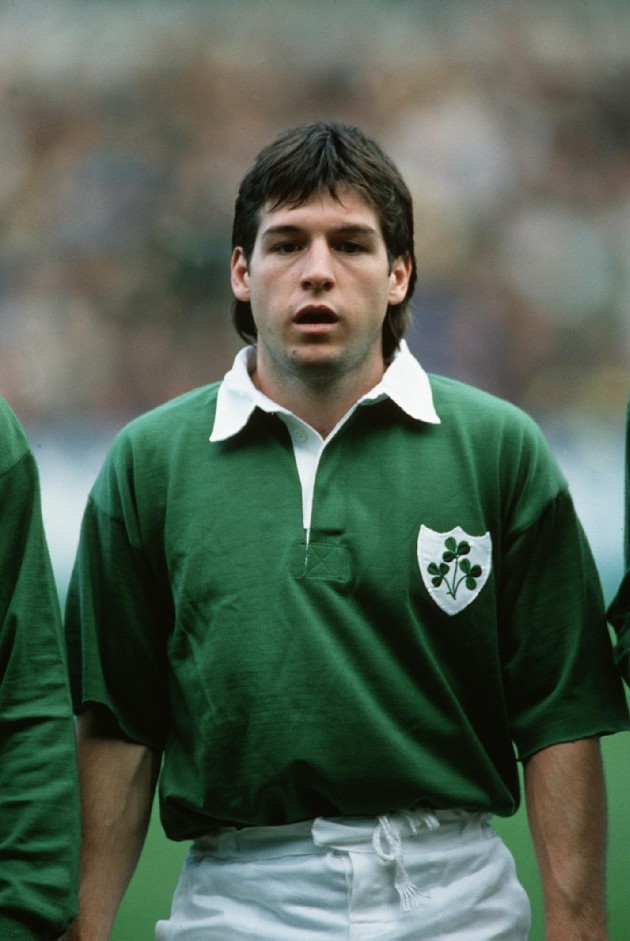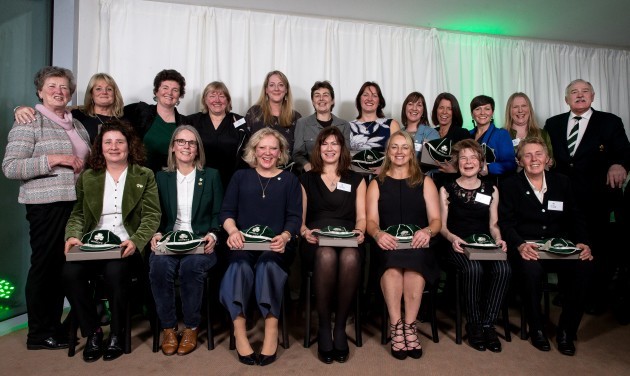‘TRAILBLAZERS’ IS OUR new series, telling the unheard stories of the women who fought for recognition in Irish rugby, and those who brought the sport to where it is today.
With Guinness – a proud sponsor of the Women’s Six Nations – The42 will pay tribute to their achievements, shine a light on the challenges they overcame, and look ahead to what’s next for women’s rugby in Ireland.
In the second instalment, Daire Walsh speaks to the first-ever captain of the Ireland women’s team — Jill Henderson.
14 February, 1993 is a date that will forever be etched in the memory of Jill Henderson.
Not only was she on the first Ireland women’s team to play in a rugby international – a test encounter against Scotland in Edinburgh – the Newtownards native also had the distinction of leading the side out as captain.
For Henderson, this was the result of a long process that had begun in earnest several months earlier.
“It all started way, way before then,” Henderson explains. “It was a journey. The match was obviously important and to captain my country was very significant, but you have to look at the whole picture.”
Maiden voyage
Playing for Waterloo in the north-west of England at the time, Henderson’s level of experience was radically different to the women’s rugby players who were based in Ireland.
The Ireland Women’s Rugby Football Union had been founded in 1992 and was still in its infancy. While the league structures on these isles were only beginning to take shape, it was much more established in the UK.
“The players in Ireland at that time, it was relatively new in comparison to what I was experiencing. In England, I was training six days a week and had been for seven years. I was playing Division One and I had a big match every weekend in the season. It was my life really.”
As well as being a member of Ireland’s squad, the versatile back-rower played a substantial role in organising the inaugural game, which was also to be a maiden international foray for Scotland. Given she was based in England and had limited resources at her disposal, the prospect of playing at a home venue was ruled out.
As it transpired, the Scots were more than happy to play host and selected an historic location for the fixture. Founded in 1857, Edinburgh Academical of Raeburn Place is the world’s second oldest rugby union club in continuous existence – just behind Dublin University (formed in 1854).
It was also where the first-ever men’s rugby international took place in 1871, a clash between Scotland and their near neighbours England.
“It was significant that we were having it there,” Henderson recalls. “It was a suitable pitch in Edinburgh on an international weekend, St Valentine’s Day. That was really good and when we were organising things, I was travelling back and forth from home to arrange the trials and get the team together.
“I had to write the constitution and fit all the criteria so that the players met the international standards and requirements.”
Along the way, Henderson encountered some resistance from those who refused to acknowledge the women’s game, but this only made her more determined to proceed with their plans.
There were a lot of people who were against it, who were not taking us seriously. People would ask silly questions like ‘Is the pitch the same size? Do you have contact? Do you tackle?’ I really couldn’t comprehend why people would ask questions like that.
“To me, this seemed perfectly normal but I was aware we weren’t accepted.”
Going green
Henderson’s desire to establish an Irish team was partly driven by the fact that she already had a potential avenue into international rugby, albeit one she had no intention to follow through with.
“I’d been offered an English trial and I had played with the England students team. I just knew that I couldn’t pull on the English jersey. It wouldn’t have felt right and there was no Irish team.
“That’s where I started to say ‘well, let’s see if we can do something about it. Let’s see if there are other people out there who have the same desire that I have’.
“Knowing that the World Cup was the following year, if we were going to do it, we’d need to have a team for that.”
A coach was required and Henderson leaned upon the healthy Blackrock contingent that made up the Ireland squad for the game. Long before becoming an acclaimed international referee, Alain Rolland was a dainty scrum-half for the south Dublin club in the All-Ireland League.
He already had one international cap under his belt – he finished his career with three in total – and was involved in coaching the ‘Rock women’s team, alongside former New Zealand and Samoa fly-half Steve Bachop.
He subsequently agreed to take charge of Ireland for their impending trip to Scotland and was a ubiquitous presence at trials and training sessions in the month leading up to the game. The then 26-year-old was tasked with selecting an Irish skipper and caught Henderson off guard when revealing his final decision.
“I hadn’t been chosen as captain until we were in Edinburgh and I wasn’t expecting that. Alain picked me and it was a real surprise. I realised afterwards that I knew everybody. I had contact with them all.
“People had confidence in me because I had been introducing myself and telling them they were on the team. The logic would be that it would transfer to the pitch.”
Even though she had an awareness of its importance, it was only in hindsight that Henderson recognised the full magnitude of the fixture. She was experienced enough to play the game rather than the occasion.
The night before my nerves were just a mess, but I knew that I had to gather myself. I had been playing at Division One level for many years, but what we were trying to achieve was a step up. I was excited and was also looking forward to it.
“To pull on that jersey, that’s what I had put in all the work for. I think that was bigger. The match was important but to focus on the enormity of it wasn’t a benefit to me.”
Unfortunately, the game didn’t quite go to plan for Ireland with a brace of Sandra Cola Martino tries propelling Scotland towards a 10-0 win. Still, Henderson was satisfied they were finally up and running with the nucleus of a squad that could sustain them over a longer period.
The world stage
Henderson continued to play on and off with Ireland over the next few years. Most notably, she featured at the hastily-arranged 1994 World Cup finals.
Originally scheduled to take place in Amsterdam from 10-24 April, it was cancelled with a few weeks to go after the event organisers failed to get endorsement as the ‘Women’s World Cup’ from the International Rugby Board.
With time running out, an alternative tournament was organised in Scotland for virtually the same dates. While it failed to get the official seal of approval from rugby authorities, the participating nations regarded it as the “real” World Cup.
For their part, the John Etheridge-coached Ireland reached the quarter-final of the tournament and achieved a seventh-place finish overall.
“It actually suited us, because it was obviously a lot easier for us to get to Scotland,” Henderson remembers of that World Cup campaign. “We had connections there and it wasn’t a disadvantage from that point of view. The bigger driver was that it was going to happen. When Holland pulled out, it was ‘my goodness, this might not happen’.
“That would have been just awful. To get there was great and we did well. At that stage, things had changed. We had a different coach with a different squad. I was a lot less involved in the organisation then, but I was still there. I played openside, which was a real shock, but it was good.”
In addition to a long stint with Waterloo (which qualified her to play for England), Henderson also lined out for Cooke, Blackrock and Old Belvedere in a distinguished club career.
I played representative right up until I was 39 for Ulster. I was very lucky. They were brilliant years. I’d love to do it all over again.
“I played at the Legends game during the 2017 World Cup, but unfortunately I was in an accident last summer. I think that was the end of my rugby.”
Finally capped
Although she achieved success in the form of silverware, Henderson ranks being the catalyst behind Ireland’s first international game as the most symbolic moment of her playing days.
This is something she came to realise in March 2018, when she was invited to the Aviva Stadium as part of a ceremony that saw 112 players – who had represented Ireland from 1993 to 2005 – finally receive their Ireland caps.
The Irish squad of the time were also in attendance on the night (having faced Scotland themselves in the Six Nations earlier on the same day) and Henderson is pleased to know she played some part in creating the landscape that the current international side operate within.
“All of those people wouldn’t have that opportunity if I hadn’t done that. Maybe they would have eventually, but it started things off more quickly than it would have been otherwise. That was a room of great people.
“They’re all committed, they all turn up. They came with a positive attitude. To be involved in that and have an influence on that, it was important for me. I was glad that I did it.”
Women’s rugby in Ireland has been transformed in the 28 years since Henderson and her fellow trailblazers first donned the green jersey. There still remains scope for change, however, and moving away from the present amateur model is something that she believes should come under consideration in the next few years.
I’d like to see the Irish team catch up with England – their set-up and their structures,” Henderson, now an architect with the Northern Ireland Housing Executive, adds. “We’re far behind them and we have been right from when I was playing.
“I’d like to see that gap narrowed in the women’s set-up. It’s not fair for women to be committed and doing as much as the men are, and then just not getting the rewards. I think it could be looked at and improved. I think that’s all we could really hope for.
“Steps forward, but maybe at a quicker rate than has happened.”


